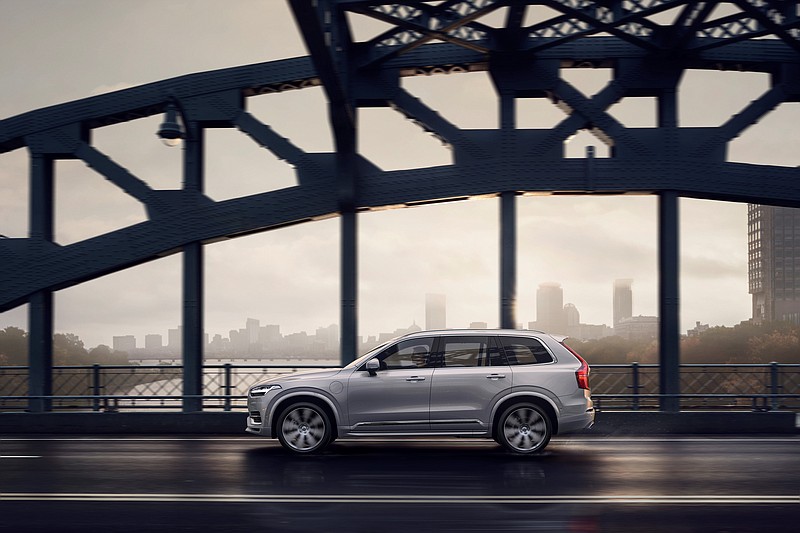If it's a luxury, three-row SUV you desire, the refreshed 2020 Volvo XC90 just became the gold standard.
Starting at $49,345 (delivery included) and stretching past $85,000 for a plug-in hybrid Inscription model with all the bells and whistles, Volvo's flagship laps competitors with its unrivaled combination of comfort, safety, and fuel economy.
We think the Volvo wins all three comparisons, especially with a Scandanavian-designed cabin crafted with grin-inspiring attention to detail, but when we start talking $100,000 behemoths like Lincoln's impressive new Navigator or Cadillac's regrettable Escalade, room exists for differences of opinion.
On safety and fuel economy, however, the big Volvo is king of the hill. Volvo's corporate mantra is that no one should die in a crash of one of its cars by 2020. The new XC90 seeks to achieve that in a wide array of ways, from outstanding passive protection to a rich variety of technology to avoid accidents in the first place.
Fuel sipper
Certainly, with the world suddenly awash in cheap gas, buyers at this level can afford all they want, but this is also a moral question. Just because we have more carbon fuel than we can use doesn't mean it's smart to burn it up.
Our 2020 XC90 T8 E-AWD Inscription (base price $63,595, as tested $86,990 delivered) came with a plug-in hybrid that delivered 23 gas-free miles every morning. After that, it seamlessly moved to its turbocharged and supercharged, 316-hp 2.0-liter four, and delivered more than 30 mpg on the highway and 28 mpg in town.
In a class where 20 mpg is seen as good, the Volvo's gas-only performance is above-average.
But wait, there's more. When the gas engine is teamed with an 87-hp motor on the rear axle and a front-mounted 34-kW motor-generator, Volvo says the combination gives the XC90 off-road capable all-wheel drive and 400 hp and 472-ft.-lb of torque.
The latter is the key number because its what one feels in the cabin: buttery smooth acceleration and power on demand. The thing will get from 0 to 60 in 5.3 giggle-inducing seconds, or haul up to 5,000 lbs.
Its speed limited to 140 mph.
The 2020 XC90 just hit these shores and it benefitted from more than a surface refresh. Volvo made substantial electro-mechanical changes, among them an increase in battery capacity. The EPA estimated the 2019 plug-in version would average 58 mpg in combined driving, but that model only went 19 miles in electric mode. Figures for the 2020 model are not yet in. As we said, we got 23. On electricity alone.
Think about that. The 60 mpg, go-anywhere, do-anything SUV is here, and it's cheaper, safer and more pleasant than a lot of competitors.
Incentives for electric cars? Who needs 'em?
Just a great car
None of the above is why should buy this SUV: Buy it because the sucker is just a great machine to drive and ride in. Especially with the 4-corner air ride suspension package ($1,800) the ride is soft but settled and handling is linear. That means it goes where it's pointed without excessive oversteer, understeer or body lean.
Volvo's leadership in the field of automotive safety is confirmed in the XC90. A new chassis design across the model lineup resulted in the strongest Volvo cars to date because of extensive use of boron steel, as well as numerous safety systems designed to protect people inside and outside the car.
Volvo's City Safety technology, standard on all Volvo models, combines automatic braking and collision avoidance systems to cover a range of potential accident scenarios. City Safety is the only system on the market that detects and reacts to pedestrians, cyclists and large animals such as moose and deer. It warns the driver and applies brakes if the driver doesn't.
A Pilot Assist driver assistance system works up to about 80 mph. It adds steering assist to adaptive cruise control to keep the car centered in its lane and a safe distance behind vehicles ahead. Take your hands off the wheel, however, and it will warn you and then turn itself off.
The Blind Spot Information System keeps an eye on any approaching traffic from the rear in either the left or right lanes. Try to pull into one of those lanes and steering assist will gently guide the car back into its lane. In a parking lot, if a driver attempts to back into the path of an oncoming car, the system will hit the brakes.
The cabin is filled with fine materials and seating is supremely comfortable, a Volvo trademark. Our tester came configured for six seats, which leaves a large space between two mid-row captain's chairs for easy access to the rear seats. There's tons of legroom up front and in the middle, but the rear is more geared to younger, or at least smaller, people.
An Inscription package ($5,300) adds Nappa leather, ventilated front seats, power cushions extensions in front, walnut wood inlays, front park assist, a 900-watt Harmon-Kardon sound system, and 20-inch wheels with all-season tires.
All those things are nice to have, but our tester took it a step further, upgrading to a $3,200 Bowers and Wilkins sound system. Pricey, but very nice indeed.
We pick one nit: Two USB outlets for a vehicle this luxurious and large are not enough.
Reviewers behind curve
Researching this vehicle on-line, we found a great deal of conflicting information. One reason is that publications have not caught up with substantial improvements made for 2020 and reviews are still guided by 2019 models. Brakes and the ride were upgraded and the digital driver display was upgraded to 12.3 inches.
Some publications downgrade Volvo's reliability, but everything concrete we found said the opposite. RepairPal.com, for example, noted Volvo's SUVs require repair slightly more often than the average, but problems are confined to interior trim and electrical items, not serious issues.
Volvo offers a relatively average warranty: 4 years/50,000 miles on basic and powertrain warranties and 8 years/100,000 miles on hybrid components, plus complimentary maintenance for 3 years/36,000 miles.
Bottom line: Volvo is owned by Geely Auto, a privately-held Chinese group. The combination of Swedish carmaking with Chinese capital and engineering is shockingly good. While America debates making more fuel-efficient vehicles, the world is building great ones.



